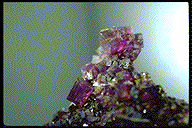

- Chemistry: Pb21Cu20Cl42(OH)40, Lead Copper Chloride Hydroxide.
- Class: Halides
- Uses: A very minor ore of lead and copper and as mineral specimens.
Specimens
Cumengite (also spelled cumengeite) is a rare mineral and of great interest to collectors of rare halides. It shares a close relationship with another rare halide, boleite. Boleite and cumengite both come from the same type locality at Boleo, Baja California, Mexico; both resulted from the oxidation of igneous copper ore bodies; both have similar chemistries, although cumengite lacks silver; both have an attractive indigo blue color and both have interesting crystal forms. But all that is not the reason for the close relationship. Cumengite and boleite have about as close a relationship as two minerals can have since cumengite actually grows on the cube faces of boleite crystals. Other minerals grow randomly on other minerals, but in this case the two structures are crystallographically oriented as if the cumengite's structure found enough of a similarity of boleite's structure to its own, that it could continue the growth where boleite left off and "finish" the crystal. This relationship is called an epitaxial overgrowth and is found on other minerals but it is cumengite's example that is most amazing. On a fully developed specimen, each of the six faces of the boleite's cube are capped with a four sided pyramid of cumengite. The resulting aggregate is a true mineralogical curiosity, a six pointed, 3 dimensional, indigo blue star. Unfortunately, there are not many complete specimens in existence and even partial stars are valuable.
Cumengite is named after Eduoard Cumenge, a French mining engineer who is believed to be the first to collect specimens of cumengite and boleite.
Cumengite contains hydroxides in its formula and belongs to a division of the
Halides Class
called the Oxyhalides and Hydroxyhalides and some other members include
bideauxite,
PHYSICAL CHARACTERISTICS:
- Color is indigo blue with violet tints.
- Luster is vitreous.
- Transparency: Crystals are usually transparent to translucent on thin edges.
- Crystal System is tetragonal
- Crystal Habits include pseudo-octahedral crystals, but more commonly found as epitaxial overgrowths on boleite. Each of the six faces of the boleite's cube can be capped with a four sided pyramid of cumengite. The result is a six pointed, 3 dimensional, star-shaped aggregate.
- Cleavage is numerous and includes four good to distinct directions and one poor direction (basal).
- Fracture is uneven and brittle.
- Hardness is 2.5
- Specific Gravity is 4.6 (rather heavy for translucent minerals)
- Streak is blue.
- Associated Minerals include pseudoboleite and especially boleite.
- Notable Occurrence is limited to the type locality of Boleo, Santa Rosalia, Baja California, Mexico.
- Best Field Indicators are crystals habit, color, density, associations and locality.





